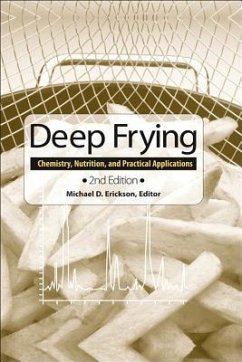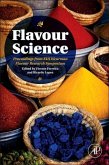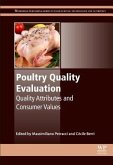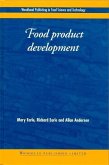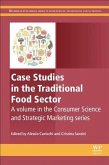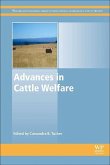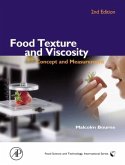Deep Frying
Chemistry, Nutrition, and Practical Applications
Herausgegeben:Erickson, Michael D.
Deep Frying
Chemistry, Nutrition, and Practical Applications
Herausgegeben:Erickson, Michael D.
- Gebundenes Buch
- Merkliste
- Auf die Merkliste
- Bewerten Bewerten
- Teilen
- Produkt teilen
- Produkterinnerung
- Produkterinnerung
Since the first edition of Deep Frying was published in 1996, there have been many changes to the U.S. Dietary Guidelines and nutritional labeling laws, and improvements in frying technology and practices have made a significant impact on the industry. This book covers everything you need to know to create fat and oil ingredients that are nutritious, uniquely palatable and satisfying.
Andere Kunden interessierten sich auch für
![Horticulture: Plants for People and Places Horticulture: Plants for People and Places]() Horticulture: Plants for People and Places527,99 €
Horticulture: Plants for People and Places527,99 €![Flavour Science Flavour Science]() Flavour Science180,99 €
Flavour Science180,99 €![Poultry Quality Evaluation Poultry Quality Evaluation]() Poultry Quality Evaluation210,99 €
Poultry Quality Evaluation210,99 €![Food Product Development Food Product Development]() M EarleFood Product Development98,99 €
M EarleFood Product Development98,99 €![Case Studies in the Traditional Food Sector Case Studies in the Traditional Food Sector]() Case Studies in the Traditional Food Sector158,99 €
Case Studies in the Traditional Food Sector158,99 €![Advances in Cattle Welfare Advances in Cattle Welfare]() Advances in Cattle Welfare184,99 €
Advances in Cattle Welfare184,99 €![Food Texture and Viscosity Food Texture and Viscosity]() Malcolm BourneFood Texture and Viscosity170,99 €
Malcolm BourneFood Texture and Viscosity170,99 €-
-
-
Since the first edition of Deep Frying was published in 1996, there have been many changes to the U.S. Dietary Guidelines and nutritional labeling laws, and improvements in frying technology and practices have made a significant impact on the industry. This book covers everything you need to know to create fat and oil ingredients that are nutritious, uniquely palatable and satisfying.
Hinweis: Dieser Artikel kann nur an eine deutsche Lieferadresse ausgeliefert werden.
Hinweis: Dieser Artikel kann nur an eine deutsche Lieferadresse ausgeliefert werden.
Produktdetails
- Produktdetails
- Verlag: Academic Press and AOCS Press / Elsevier Science & Technology
- Artikelnr. des Verlages: C2015-0-02457-1
- 2. Aufl.
- Seitenzahl: 464
- Erscheinungstermin: 13. April 2007
- Englisch
- Abmessung: 229mm x 152mm
- Gewicht: 860g
- ISBN-13: 9781893997929
- ISBN-10: 1893997928
- Artikelnr.: 67578738
- Herstellerkennzeichnung
- Libri GmbH
- Europaallee 1
- 36244 Bad Hersfeld
- gpsr@libri.de
- Verlag: Academic Press and AOCS Press / Elsevier Science & Technology
- Artikelnr. des Verlages: C2015-0-02457-1
- 2. Aufl.
- Seitenzahl: 464
- Erscheinungstermin: 13. April 2007
- Englisch
- Abmessung: 229mm x 152mm
- Gewicht: 860g
- ISBN-13: 9781893997929
- ISBN-10: 1893997928
- Artikelnr.: 67578738
- Herstellerkennzeichnung
- Libri GmbH
- Europaallee 1
- 36244 Bad Hersfeld
- gpsr@libri.de
Michael D. Erickson spent time as a Technical Service Manager for Cargill Dressing, Sauces and Oils in Fullerton, California. He started his career in 1981 with Interstate Foods Corp., Chicago, IL, which, at the time, was the sole supplier of frying fat to the McDonald's system. He worked closely with the largest international quick-service restaurant chains and food processors as primary technical lead for matters related to frying including product development, equipment evaluation and education.
In 1990 he started work for Humko Oils division of Kraft Food Ingredients in Memphis, TN, where, in addition to continued work in the frying industry, he led various projects including alternatives to hydrogenation and identification and development of biotechnology oil through the partnership with Pioneer Hi-Bred International, Inc. He also worked extensively in edible oil processing on projects involving new refining technologies and identification of productivity opportunities in each unit process (refining, bleaching, hydrogenation, deodorization, winterization).
His work at Cargill included continued active participation in the frying and frying related industry in addition to pioneering product and service support for unique customer solutions involving any food ingredient. He is a member of the American Oil Chemists' Society having served as the technical chairperson for the 1993 Annual Meeting (Anaheim, CA), and member of the AOCS Governing Board. He developed and chaired two AOCS Laboratory Short Courses on Frying Fats and co-chair for frying fat sessions with Dr. Perkins.
In 1990 he started work for Humko Oils division of Kraft Food Ingredients in Memphis, TN, where, in addition to continued work in the frying industry, he led various projects including alternatives to hydrogenation and identification and development of biotechnology oil through the partnership with Pioneer Hi-Bred International, Inc. He also worked extensively in edible oil processing on projects involving new refining technologies and identification of productivity opportunities in each unit process (refining, bleaching, hydrogenation, deodorization, winterization).
His work at Cargill included continued active participation in the frying and frying related industry in addition to pioneering product and service support for unique customer solutions involving any food ingredient. He is a member of the American Oil Chemists' Society having served as the technical chairperson for the 1993 Annual Meeting (Anaheim, CA), and member of the AOCS Governing Board. He developed and chaired two AOCS Laboratory Short Courses on Frying Fats and co-chair for frying fat sessions with Dr. Perkins.
Part 1 Overview
1. Production and Composition of Frying Fats
2. Storage and Handling of Finished Frying Oils
3. Initial Quality of Frying Oil
Part 2 Physical Characteristics
4. Volatile Odor and Flavor Components Formed in Deep Frying
5. Isomeric and Cyclic Fatty Acids as a Result of Frying
6. Formation and Analysis of Oxidized Monomeric, Dimeric, and Higher Oligomeric Triglycerides
7. Formation, Analysis, and Health Effects of Oxidized Sterols in Frying Fat
Part 3 Nutrition
8. Role of Fat in the Diet
9. Nutritional and Physiological Effects of Used Frying Oils and Fats
10. Physiological Effects of trans and Cyclic Fatty Acids
11. The Chemistry and Nutrition of Nonnutritive Fats
Part 4 Application
12. Dynamics of Frying
13. Foodservice Frying
14. Industrial Frying
15. Practical Foodservice Frying: Troubleshooting
Part 5 Evaluation
16. General Considerations for Designing Laboratory Scale Fry-Tests
17. Designing Field Frying Tests
18. Evaluation of Used Frying Oil
19. Evaluation of Passive and Active Filter Media
20. Sensory Evaluation of Frying Fat and Deep-Fried Products
Part 6 Regulation
21. Regulation of Frying Fat and Oil
22. Environmental Concerns
23. Options for Reducing/Eliminating trans Fatty Acids in Deep Fat Frying and Labeling Implications
24. Current and Future Frying Issues
1. Production and Composition of Frying Fats
2. Storage and Handling of Finished Frying Oils
3. Initial Quality of Frying Oil
Part 2 Physical Characteristics
4. Volatile Odor and Flavor Components Formed in Deep Frying
5. Isomeric and Cyclic Fatty Acids as a Result of Frying
6. Formation and Analysis of Oxidized Monomeric, Dimeric, and Higher Oligomeric Triglycerides
7. Formation, Analysis, and Health Effects of Oxidized Sterols in Frying Fat
Part 3 Nutrition
8. Role of Fat in the Diet
9. Nutritional and Physiological Effects of Used Frying Oils and Fats
10. Physiological Effects of trans and Cyclic Fatty Acids
11. The Chemistry and Nutrition of Nonnutritive Fats
Part 4 Application
12. Dynamics of Frying
13. Foodservice Frying
14. Industrial Frying
15. Practical Foodservice Frying: Troubleshooting
Part 5 Evaluation
16. General Considerations for Designing Laboratory Scale Fry-Tests
17. Designing Field Frying Tests
18. Evaluation of Used Frying Oil
19. Evaluation of Passive and Active Filter Media
20. Sensory Evaluation of Frying Fat and Deep-Fried Products
Part 6 Regulation
21. Regulation of Frying Fat and Oil
22. Environmental Concerns
23. Options for Reducing/Eliminating trans Fatty Acids in Deep Fat Frying and Labeling Implications
24. Current and Future Frying Issues
Part 1 Overview
1. Production and Composition of Frying Fats
2. Storage and Handling of Finished Frying Oils
3. Initial Quality of Frying Oil
Part 2 Physical Characteristics
4. Volatile Odor and Flavor Components Formed in Deep Frying
5. Isomeric and Cyclic Fatty Acids as a Result of Frying
6. Formation and Analysis of Oxidized Monomeric, Dimeric, and Higher Oligomeric Triglycerides
7. Formation, Analysis, and Health Effects of Oxidized Sterols in Frying Fat
Part 3 Nutrition
8. Role of Fat in the Diet
9. Nutritional and Physiological Effects of Used Frying Oils and Fats
10. Physiological Effects of trans and Cyclic Fatty Acids
11. The Chemistry and Nutrition of Nonnutritive Fats
Part 4 Application
12. Dynamics of Frying
13. Foodservice Frying
14. Industrial Frying
15. Practical Foodservice Frying: Troubleshooting
Part 5 Evaluation
16. General Considerations for Designing Laboratory Scale Fry-Tests
17. Designing Field Frying Tests
18. Evaluation of Used Frying Oil
19. Evaluation of Passive and Active Filter Media
20. Sensory Evaluation of Frying Fat and Deep-Fried Products
Part 6 Regulation
21. Regulation of Frying Fat and Oil
22. Environmental Concerns
23. Options for Reducing/Eliminating trans Fatty Acids in Deep Fat Frying and Labeling Implications
24. Current and Future Frying Issues
1. Production and Composition of Frying Fats
2. Storage and Handling of Finished Frying Oils
3. Initial Quality of Frying Oil
Part 2 Physical Characteristics
4. Volatile Odor and Flavor Components Formed in Deep Frying
5. Isomeric and Cyclic Fatty Acids as a Result of Frying
6. Formation and Analysis of Oxidized Monomeric, Dimeric, and Higher Oligomeric Triglycerides
7. Formation, Analysis, and Health Effects of Oxidized Sterols in Frying Fat
Part 3 Nutrition
8. Role of Fat in the Diet
9. Nutritional and Physiological Effects of Used Frying Oils and Fats
10. Physiological Effects of trans and Cyclic Fatty Acids
11. The Chemistry and Nutrition of Nonnutritive Fats
Part 4 Application
12. Dynamics of Frying
13. Foodservice Frying
14. Industrial Frying
15. Practical Foodservice Frying: Troubleshooting
Part 5 Evaluation
16. General Considerations for Designing Laboratory Scale Fry-Tests
17. Designing Field Frying Tests
18. Evaluation of Used Frying Oil
19. Evaluation of Passive and Active Filter Media
20. Sensory Evaluation of Frying Fat and Deep-Fried Products
Part 6 Regulation
21. Regulation of Frying Fat and Oil
22. Environmental Concerns
23. Options for Reducing/Eliminating trans Fatty Acids in Deep Fat Frying and Labeling Implications
24. Current and Future Frying Issues

